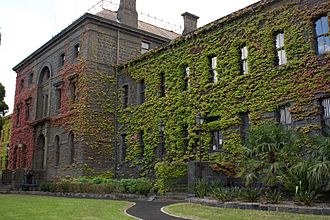Victoria Barracks, Melbourne facts for kids
Quick facts for kids Victoria Barracks |
|
|---|---|
 |
|
| General information | |
| Architectural style | Renaissance Revival |
| Town or city | Melbourne |
| Country | Australia |
| Coordinates | 37°49′39″S 144°58′14″E / 37.827391°S 144.970447°E |
| Construction started | 1856 |
| Completed | 1872 |
Victoria Barracks Melbourne is an important Australian Government building. It is located on St Kilda Road in Melbourne, Australia. This historic site was built in the mid-to-late 1800s. It first served as a home for British colonial soldiers in Australia.
Later, from 1901 to 1953, it became the main office for Australia's Department of Defence. During World War II, it even housed Australia's special war cabinet. Today, Victoria Barracks is still used as an administrative center for the Department of Defence.
Contents
The Story of Victoria Barracks
Early Days: Home for Soldiers
Victoria Barracks was first built to house British soldiers. These soldiers included the 12th and 40th Regiments of Foot. They were involved in stopping the Eureka Stockade rebellion in Ballarat, Victoria. After the British troops left, the barracks became home to Victoria's own colonial forces.
The very first building, called G Block, was constructed by soldiers of the 40th Regiment. This happened between 1856 and 1858. Other buildings were added by civil contractors. Many of the original buildings were made from bluestone and finished by 1872.
A New Role: Defence Headquarters
After Australia became a federation in 1901, Victoria Barracks took on a new role. It became the home for the new Department of Defence. In 1917, a large addition called A Block New Wing was built. It looked like the older A Block but had modern construction and interiors for its time.
In 1936, a part of the land was used to build the Repatriation Commission Outpatient Clinic. This clinic opened in 1937. It was designed in the Art Deco style for veterans of World War I.
Another modern Art Deco building, M Block, was added in 1939. Its floor was special because it was the first continuous concrete pour in Australia. The barracks were named in honor of Queen Victoria. There are also Victoria Barracks in Sydney and Brisbane.
Victoria Barracks During World War II
During World War II, Victoria Barracks Melbourne played a very important part. It housed the Australian War Cabinet. This group included senior politicians from both the government and opposition parties. They made big decisions for the country during the war.
The Defence Secretariat worked on the second floor of A Block New Wing. This area also had offices for important military staff and the Secretary of the Department of Defence. Australia's wartime Prime Ministers, Robert Menzies and later John Curtin, also had offices near the War Cabinet Room.
A secret Navy code-breaking unit, led by Eric Nave, was also at Victoria Barracks for a time.
There's a popular story that American General Douglas MacArthur had an office here. However, this isn't true; his main office was at the Hotel Australia in Melbourne. Instead, it was General Sir Thomas Blamey, a very important Australian military leader, who had his headquarters at the barracks. He was Commander-in-Chief of Australian Military Forces.
Victoria Barracks Today
Today, Victoria Barracks Melbourne is still a busy place. It houses several important groups that help run Australia's defence.
Some of the groups located here include:
- Land Systems Division (LSD), which is part of the Capability Acquisition and Sustainment Group.
- Ten Systems Program Offices (SPO) that are business units of LSD.
- Parts of Joint Logistics Command (JLC).
- Parts of Estate and Infrastructure Group (E&IG).
- The Senior Naval Officer for Victoria (SNO-Vic).
Other organizations that work within Victoria Barracks are:
- The Royal United Services Institute (RUSI) library.
- The Defence Force Welfare Association (DFWA).
- Ventia Defence contractors, who provide support services.
- Australian Military Bank.
- Defence Bank.
- An Australian Federal Police detachment.
Many places within Victoria Barracks are named after important military events, people, or locations. These include:
- Shedden Auditorium, named after Sir Frederick Shedden.
- The War Cabinet Room, where the World War II War Cabinet met.
- Blamey Room, named after Field Marshal Sir Thomas Blamey.
- Tresco Room, named after the Tresco Estate, a special residence for the Royal Australian Navy.
The Former Repatriation Clinic
The old Repatriation Commission Outpatient Clinic, built before World War II, was given back to Defence in 1980. It was used for engineering work until 1995. The building has been empty since then. The Department of Defence tried to sell the property several times, but it was taken off the sale list in February 2022.

